Spatiotemporal Footprints of Surface Urban Heat Islands in the Urban Agglomeration of Yangtze River Delta During 2000–2022
Abstract
1. Introduction
2. Materials and Methods
2.1. Data Sources and Preprocessing
2.2. Estimation of the Local LST Anomaly Related to Urbanization
2.3. Automatically Detecting Each Annual Cycle of the Urban Reference LSTA Series
2.4. Quantifying SUHI Footprints from the Structural Similarity of LSTA Annual Cycles
2.5. Selection of the Optimal Urban LSTA Reference Series Having Stable SUHI Effects
3. Results
3.1. Temporal Variations in the Footprint of SUHIs in the YRDUA Region During 2000–2022
3.2. Spatial Expansions of the SUHIs in the YRDUA Region During 2000–2022
3.3. ISA Proportion Threshold of Urban and Built-Up Areas Related to a Stable SUHI Phenomenon
3.4. Temporal Variations in SUHI Extent at Different SUHI Intensities in the SUHI Zone
4. Discussion
4.1. Advantages of the SSIM-Based Method in Quantifying Regional SUHIs
4.2. Potential Implications of the SSIM-Estimated SUHIs in Urban Planning
4.3. Uncertainties of SSIM-Estimated SUHIs over Urban Agglomerations
5. Conclusions
Author Contributions
Funding
Data Availability Statement
Conflicts of Interest
References
- Voogt, J.A.; Oke, T.R. Thermal remote sensing of urban climates. Remote Sens. Environ. 2003, 86, 370–384. [Google Scholar] [CrossRef]
- Manoli, G.; Fatichi, S.; Schläpfer, M.; Yu, K.L.; Crowther, T.W.; Meili, N.; Burlando, P.; Katul, G.G.; Bou-Zeid, E. Magnitude of urban heat islands largely explained by climate and population. Nature 2019, 573, 55–60. [Google Scholar] [CrossRef] [PubMed]
- Oke, T.R.; Mills, G.; Christen, A.; Voogt, J.A. Urban Climates; Cambridge University Press: Cambridge, UK, 2017. [Google Scholar] [CrossRef]
- Stewart, I.D.; Krayenhoff, E.S.; Voogt, J.A.; Lachapelle, J.A.; Broadbent, A.M. Time evolution of the surface urban heat island. Earths Future 2021, 9, e2021EF002178. [Google Scholar] [CrossRef]
- Hu, J.; Yang, Y.B.; Zhou, Y.Y.; Zhang, T.; Ma, Z.F.; Meng, X.J. Spatial patterns and temporal variations of footprint and intensity of surface urban heat island in 141 China cities. Sustain. Cities Soc. 2022, 77, 103585. [Google Scholar] [CrossRef]
- Venter, Z.S.; Chakraborty, T.; Lee, X.H. Crowdsourced air temperatures contrast satellite measures of the urban heat island and its mechanisms. Sci. Adv. 2021, 7, eabb9569. [Google Scholar] [CrossRef]
- Li, X.M.; Asrar, G.R.; Imhoff, M.; Li, X.C. The surface urban heat island response to urban expansion: A panel analysis for the conterminous United States. Sci. Total Environ. 2017, 605, 426–435. [Google Scholar] [CrossRef]
- Zhou, X.F.; Chen, H. Impact of urbanization-related land use land cover changes and urban morphology changes on the urban heat island phenomenon. Sci. Total Environ. 2018, 635, 1467–1476. [Google Scholar] [CrossRef]
- Lyu, H.; Wang, W.; Zhang, K.E.; Cao, C.; Xiao, W.; Lee, X.H. Factors influencing the spatial variability of air temperature urban heat island intensity in Chinese cities. Adv. Atmos. Sci. 2024, 41, 817–829. [Google Scholar] [CrossRef]
- Mathivanan, M.; Duraisekaran, E. Identification and quantification of localized urban heat island intensity and footprint for Chennai Metropolitan Area during 1988–2023. Environ. Monit. Assess. 2025, 197, 91. [Google Scholar] [CrossRef]
- United Nations, Department of Economic and Social Affairs, Population Division. World Urbanization Prospects: The 2018 Revision; United Nations: New York, NY, USA, 2019; Available online: https://www.un.org/development/desa/pd/sites/www.un.org.development.desa.pd/files/files/documents/2020/Feb/un_2018_wup_highlights.pdf (accessed on 1 February 2025).
- Fang, C.L.; Yu, D.L. Urban agglomeration: An evolving concept of an emerging phenomenon. Landsc. Urban Plan. 2017, 162, 126–136. [Google Scholar] [CrossRef]
- Geng, S.B.; Yang, L.; Sun, Z.Y.; Wang, Z.H.; Qian, J.X.; Jiang, C.; Wen, M.L. Spatiotemporal patterns and driving forces of remotely sensed urban agglomeration heat islands in South China. Sci. Total Environ. 2021, 800, 149499. [Google Scholar] [CrossRef] [PubMed]
- Wang, Z.A.; Meng, Q.Y.; Allam, M.; Hu, D.; Zhang, L.L.; Menenti, M. Environmental and anthropogenic drivers of surface urban heat island intensity: A case-study in the Yangtze River Delta, China. Ecol. Indic. 2021, 128, 107845. [Google Scholar] [CrossRef]
- Wu, Z.F.; Xu, Y.; Cao, Z.; Yang, J.X.; Zhu, H. Impact of urban agglomeration and physical and socioeconomic factors on surface urban heat islands in the Pearl River Delta Region, China. IEEE J. Sel. Top. Appl. Earth Obs. Remote Sens. 2021, 14, 8815–8822. [Google Scholar] [CrossRef]
- Fu, X.C.; Yao, L.; Xu, W.T.; Wang, Y.X.; Sun, S. Exploring the multi-temporal surface urban heat island effect and its driving relation in the Beijing-Tianjin-Hebei urban agglomeration. Appl. Geogr. 2022, 144, 102714. [Google Scholar] [CrossRef]
- Peng, J.; Qiao, R.L.; Wang, Q.; Yu, S.Y.; Dong, J.Q.; Yang, Z.W. Diversified evolutionary patterns of surface urban heat island in new expansion areas of 31 Chinese cities. Npj Urban Sustain. 2024, 4, 14. [Google Scholar] [CrossRef]
- Ren, J.Y.; Yang, J.; Yu, W.B.; Cong, N.; Xiao, X.M.; Xia, J.H.; Li, X.M. Spatiotemporal evolution of surface urban heat islands: Concerns regarding summer heat wave periods. J. Geogr. Sci. 2024, 34, 1065–1082. [Google Scholar] [CrossRef]
- Zhang, H.; Cen, X.H.; An, H.; Yin, Y.X. Quantitative assessment and driving factors analysis of surface urban heat island of urban agglomerations in China based on GEE. Environ. Sci. Pollut. Res. 2024, 31, 47350–47364. [Google Scholar] [CrossRef]
- Xie, Z.Q.; Du, Y.; Miao, Q.; Zhang, L.L.; Wang, N. An approach to characterizing the spatial pattern and scale of regional heat islands over urban agglomerations. Geophys. Res. Lett. 2022, 49, e2022GL099117. [Google Scholar] [CrossRef]
- Du, Y.; Xie, Z.Q.; Zhang, L.L.; Wang, N.; Wang, M.; Hu, J.W. Machine-learning-assisted characterization of regional heat islands with a spatial extent larger than the urban size. Remote Sens. 2024, 16, 599. [Google Scholar] [CrossRef]
- Zhou, D.C.; Zhao, S.Q.; Zhang, L.X.; Sun, G.; Liu, Y.Q. The footprint of urban heat island effect in China. Sci. Rep. 2015, 5, 11160. [Google Scholar] [CrossRef]
- Si, M.; Li, Z.L.; Nerry, F.; Tang, B.H.; Leng, P.; Wu, H.; Zhang, X.; Shang, G. Spatiotemporal pattern and long-term trend of global surface urban heat islands characterized by dynamic urban-extent method and MODIS data. ISPRS J. Photogramm. 2022, 183, 321–335. [Google Scholar] [CrossRef]
- Wang, R.; Voogt, J.; Ren, C.; Ng, E. Spatial-temporal variations of surface urban heat island: An application of local climate zone into large Chinese cities. Build. Environ. 2022, 222, 109378. [Google Scholar] [CrossRef]
- Martin, P.; Baudouin, Y.; Gachon, P. An alternative method to characterize the surface urban heat island. Int. J. Biometeorol. 2015, 59, 849–861. [Google Scholar] [CrossRef] [PubMed]
- Liu, Y.H.; Fang, X.Y.; Xu, Y.M.; Zhang, S.; Luan, Q.Z. Assessment of surface urban heat island across China’s three main urban agglomerations. Theor. Appl. Climatol. 2018, 133, 473–488. [Google Scholar] [CrossRef]
- Sun, Y.W.; Gao, C.; Li, J.L.; Wang, R.; Liu, J. Evaluating urban heat island intensity and its associated determinants of towns and cities continuum in the Yangtze River Delta urban agglomerations. Sustain. Cities Soc. 2019, 50, 101659. [Google Scholar] [CrossRef]
- Liu, H.M.; Huang, B.; Zhan, Q.M.; Gao, S.H.; Li, R.R.; Fan, Z.Y. The influence of urban form on surface urban heat island and its planning implications: Evidence from 1288 urban clusters in China. Sustain. Cities Soci. 2021, 71, 102987. [Google Scholar] [CrossRef]
- Hsu, A.; Sheriff, G.; Chakraborty, T.; Manya, D. Disproportionate exposure to urban heat island intensity across major US cities. Nat. Commun. 2021, 12, 2721. [Google Scholar] [CrossRef]
- Yao, R.; Huang, X.; Zhang, Y.J.; Wang, L.C.; Li, J.Y.; Yang, Q.Q. Estimation of the surface urban heat island intensity across 1031 global cities using the regression-modification-estimation (RME) method. J. Clean. Prod. 2024, 434, 140231. [Google Scholar] [CrossRef]
- Li, Y.F.; Schubert, S.; Kropp, J.P.; Rybski, D. On the influence of density and morphology on the Urban Heat Island intensity. Nat. Commun. 2020, 11, 2647. [Google Scholar] [CrossRef]
- Acosta, M.P.; Vahdatikhaki, F.; Santos, J.; Hammad, A.; Dor′ee, A.G. How to bring UHI to the urban planning table? A data-driven modeling approach. Sustain. Cities Soc. 2021, 71, 102948. [Google Scholar] [CrossRef]
- Yang, Q.Q.; Xu, Y.; Tong, X.H.; Huang, X.; Liu, Y.; Chakraborty, T.C.; Xia, C.J.; Hu, T. An adaptive synchronous extraction (ASE) method for estimating intensity and footprint of surface urban heat islands: A case study of 254 North American cities. Remote Sens. Environ. 2023, 297, 113777. [Google Scholar] [CrossRef]
- Yao, R.; Wang, L.C.; Huang, X.; Niu, Y.; Chen, Y.S.; Niu, Z.G. The influence of different data and methods on estimating the surface urban heat island intensity. Ecol. Indic. 2018, 89, 45–55. [Google Scholar] [CrossRef]
- Hou, H.; Estoque, R.C. Detecting cooling effect of landscape from composition and configuration: An urban heat island study on Hangzhou. Urban For. Urban Gree. 2020, 53, 126719. [Google Scholar] [CrossRef]
- Soydan, O. Effects of landscape composition and patterns on land surface temperature: Urban heat island case study for Nigde, Turkey. Urban Clim. 2020, 34, 100688. [Google Scholar] [CrossRef]
- Wang, Q.; Wang, X.N.; Zhou, Y.; Liu, D.Y.; Wang, H.T. The dominant factors and influence of urban characteristics on land surface temperature using random forest algorithm. Sustain. Cities Soc. 2022, 79, 103722. [Google Scholar] [CrossRef]
- Xiang, Y.; Ye, Y.; Peng, C.C.; Teng, M.J.; Zhou, Z.X. Seasonal variations for combined effects of landscape metrics on land surface temperature (LST) and aerosol optical depth (AOD). Ecol. Indic. 2022, 138, 108810. [Google Scholar] [CrossRef]
- Ezimand, K.; Azadbakht, M.; Aghighi, H. Analyzing the effects of 2D and 3D urban structures on LST changes using remotely sensed data. Sustain. Cities Soci. 2021, 74, 103216. [Google Scholar] [CrossRef]
- Taripanah, F.; Ranjbar, A. Quantitative analysis of spatial distribution of land surface temperature (LST) in relation ecohydrological, terrain and socio-economic factors based on Landsat data in mountainous area. Adv. Space Res. 2021, 68, 3622–3640. [Google Scholar] [CrossRef]
- Yang, J.; Huang, X. The 30 m annual land cover dataset and its dynamics in China from 1990 to 2019. Earth Syst. Sci. Data 2021, 13, 3907–3925. [Google Scholar] [CrossRef]
- Zhao, M.; Cheng, C.X.; Zhou, Y.Y.; Li, X.C.; Shen, S.; Song, C.Q. A global dataset of annual urban extents (1992–2020) from harmonized nighttime lights. Earth Syst. Sci. Data 2022, 14, 517–534. [Google Scholar] [CrossRef]
- Somvanshi, S.S.; Kumari, M.; Sharma, R. Spatio-temporal analysis of rural-urban transitions and transformations in Gautam Buddha Nagar, India. Int. J. Environ. Sci. Technol. 2024, 21, 5079–5088. [Google Scholar] [CrossRef]
- Adilkhanova, I.; Ngarambe, J.; Yun, G.Y. Recent advances in black box and white-box models for urban heat island prediction: Implications of fusing the two methods. Renew. Sust. Energ. Rev. 2022, 165, 112520. [Google Scholar] [CrossRef]
- Yang, Q.Q.; Huang, X.; Tang, Q.H. The footprint of urban heat island effect in 302 Chinese cities: Temporal trends and associated factors. Sci. Total Environ. 2019, 655, 652–662. [Google Scholar] [CrossRef] [PubMed]
- Shen, P.K.; Zhao, S.Q. Intensifying urban imprint on land surface warming: Insights from local to global scale. iScience 2024, 27, 109110. [Google Scholar] [CrossRef]
- Yu, Z.W.; Yao, Y.W.; Yang, G.Y.; Wang, X.R.; Vejre, H. Spatiotemporal patterns and characteristics of remotely sensed region heat islands during the rapid urbanization (1995–2015) of southern China. Sci. Total Environ. 2019, 674, 242–254. [Google Scholar] [CrossRef]
- Hou, L.; Yue, W.Z.; Liu, X. Spatiotemporal patterns and drivers of summer heat island in Beijing-Tianjin-Hebei Urban Agglomeration, China. IEEE J. Sel. Top. Appl. Earth Obs. Remote Sens. 2021, 14, 7516–7527. [Google Scholar] [CrossRef]
- Yao, L.; Sun, S.; Song, C.Y.; Li, J.; Xu, W.T.; Xu, Y. Understanding the spatiotemporal pattern of the urban heat island footprint in the context of urbanization, a case study in Beijing, China. Appl. Geogr. 2021, 133, 102496. [Google Scholar] [CrossRef]
- Han, J.; Mo, N.; Cai, J.Y.; Ouyang, L.X.; Liu, Z.X. Advancing the local climate zones framework: A critical review of methodological progress, persisting challenges, and future research prospects. Hum. Soc. Sci. Commun. 2024, 11, 538. [Google Scholar] [CrossRef]
- Stewart, I.D.; Oke, T.R. Local Climate Zones for Urban Temperature Studies. Bull. Am. Meteorol. Soc. 2012, 93, 1879–1900. [Google Scholar] [CrossRef]
- Bechtel, B.; Demuzere, M.; Mills, G.; Zhan, W.F.; Sismanidis, P.; Small, C.; Voogt, J. SUHI analysis using local climate zones—A comparison of 50 cities. Urban Clim. 2019, 28, 100451. [Google Scholar] [CrossRef]
- Demuzere, M.; Kittner, J.; Martilli, A.; Mills, G.; Moede, C.; Stewart, I.D.; van Vliet, J.; Bechtel, B. A global map of local climate zones to support earth system modeling and urban-scale environmental science. Earth Syst. Sci. Data 2022, 14, 3835–3873. [Google Scholar] [CrossRef]
- Rahmani, N.; Sharifi, A. Urban heat dynamics in Local Climate Zones (LCZs): A systematic review. Build. Environ. 2025, 267, 112225. [Google Scholar] [CrossRef]
- Mohammad, P.; Goswami, A.; Chauhan, S.; Nayak, S. Machine learning algorithm based prediction of land use land cover and land surface temperature changes to characterize the surface urban heat island phenomena over Ahmedabad city, India. Urban Clim. 2022, 42, 101116. [Google Scholar] [CrossRef]
- Wang, Z.; Bovik, A.C.; Sheikh, H.R.; Simoncelli, E.P. Image quality assessment: From error visibility to structural similarity. IEEE Trans. Image Process. 2004, 13, 600–611. [Google Scholar] [CrossRef]
- Jia, A.L.; Liang, S.L.; Wang, D.D.; Malick, K.; Zhou, S.G.; Hu, T.; Xu, S. Advances in methodology and generation of all-weather land surface temperature products from polar-orbiting and geostationary satellites: A comprehensive review. IEEE Geosci. Remote Sens. Mag. 2024, 12, 218–260. [Google Scholar] [CrossRef]
- Zhang, T.; Zhou, Y.Y.; Zhu, Z.Y.; Li, X.M.; Asrar, G.R. A global seamless 1 km resolution daily land surface temperature dataset (2003–2020). Earth Syst. Sci. Data 2022, 14, 651–664. [Google Scholar] [CrossRef]
- Tang, W.B.; Zhou, J.; Ma, J.; Wang, Z.W.; Ding, L.R.; Zhang, X.D.; Zhang, X. TRIMS LST: A daily 1 km all-weather land surface temperature dataset for China’s landmass and surrounding areas (2000–2022). Earth Syst. Sci. Data 2024, 16, 387–419. [Google Scholar] [CrossRef]
- Abercrombie, S.P.; Friedl, M.A. Improving the consistency of multitemporal land cover maps using a hidden Markov model. IEEE Trans. Geosci. Remote Sens. 2016, 54, 703–713. [Google Scholar] [CrossRef]
- Liang, S.L.; Cheng, C.; Jia, K.; Jiang, B.; Liu, Q.; Xiao, Z.Q.; Yao, Y.J.; Yuan, W.; Zhang, X.T.; Zhao, X.; et al. The Global Land Surface Satellite (GLASS) products suite. Bull. Am. Meteorol. Soc. 2021, 102, E323. [Google Scholar] [CrossRef]
- Amatulli, G.; Domisch, S.; Tuanmu, M.N.; Parmentier, B.; Ranipeta, A.; Malczyk, J.; Jetz, W. A suite of global, cross-scale topographic variables for environmental and biodiversity modeling. Sci. Data 2018, 5, 180040. [Google Scholar] [CrossRef]
- Breiman, L. Random forests. Mach. Learn. 2001, 45, 5–32. [Google Scholar] [CrossRef]
- Scholkmann, F.; Boss, J.; Wolf, M. An efficient algorithm for automatic peak detection in noisy periodic and quasi-periodic signals. Algorithms 2012, 5, 588–603. [Google Scholar] [CrossRef]
- Kuang, W.H. Mapping global impervious surface area and green space within urban environments. Sci. China Earth Sci. 2019, 62, 1591–1606. [Google Scholar] [CrossRef]
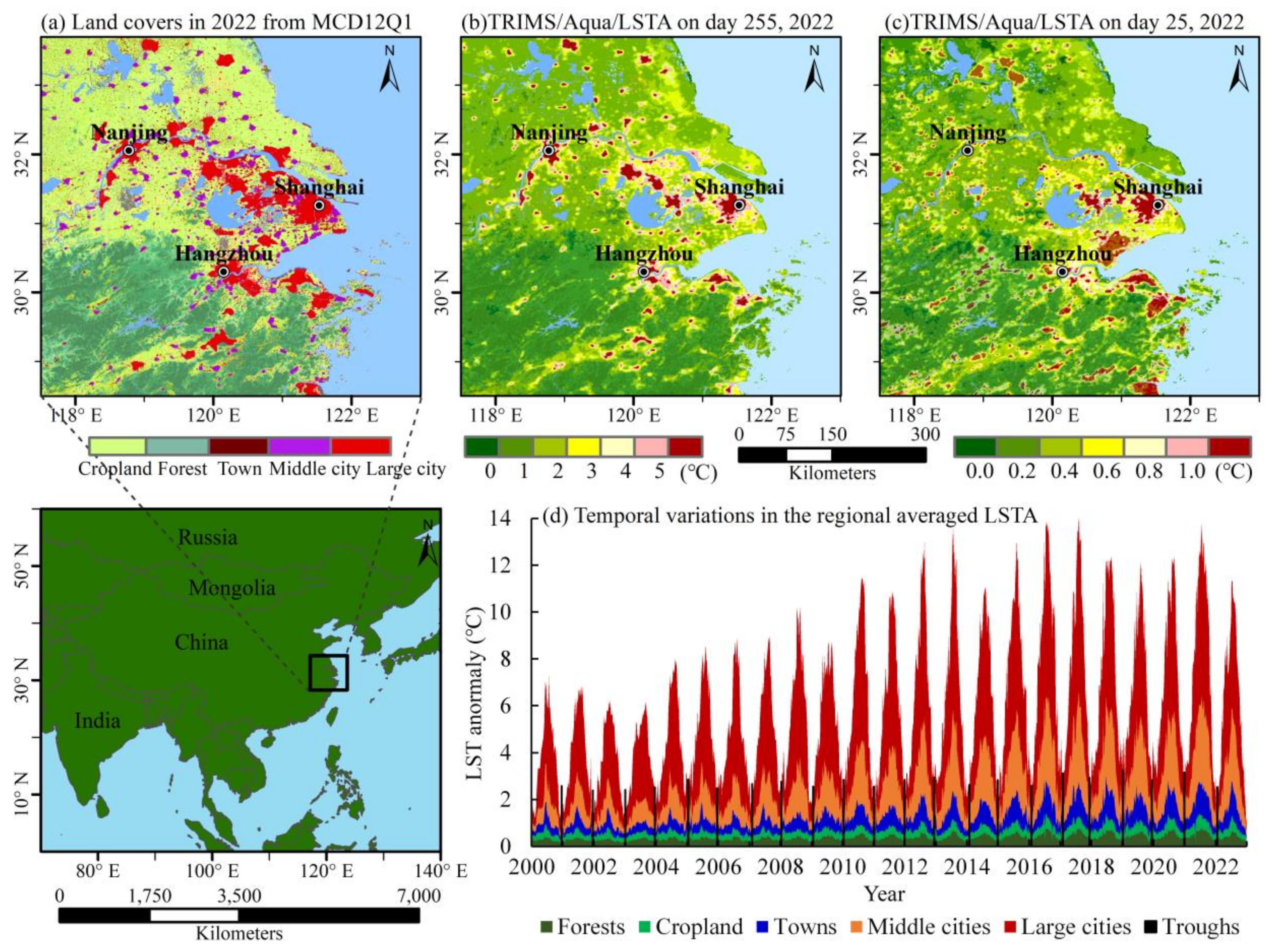
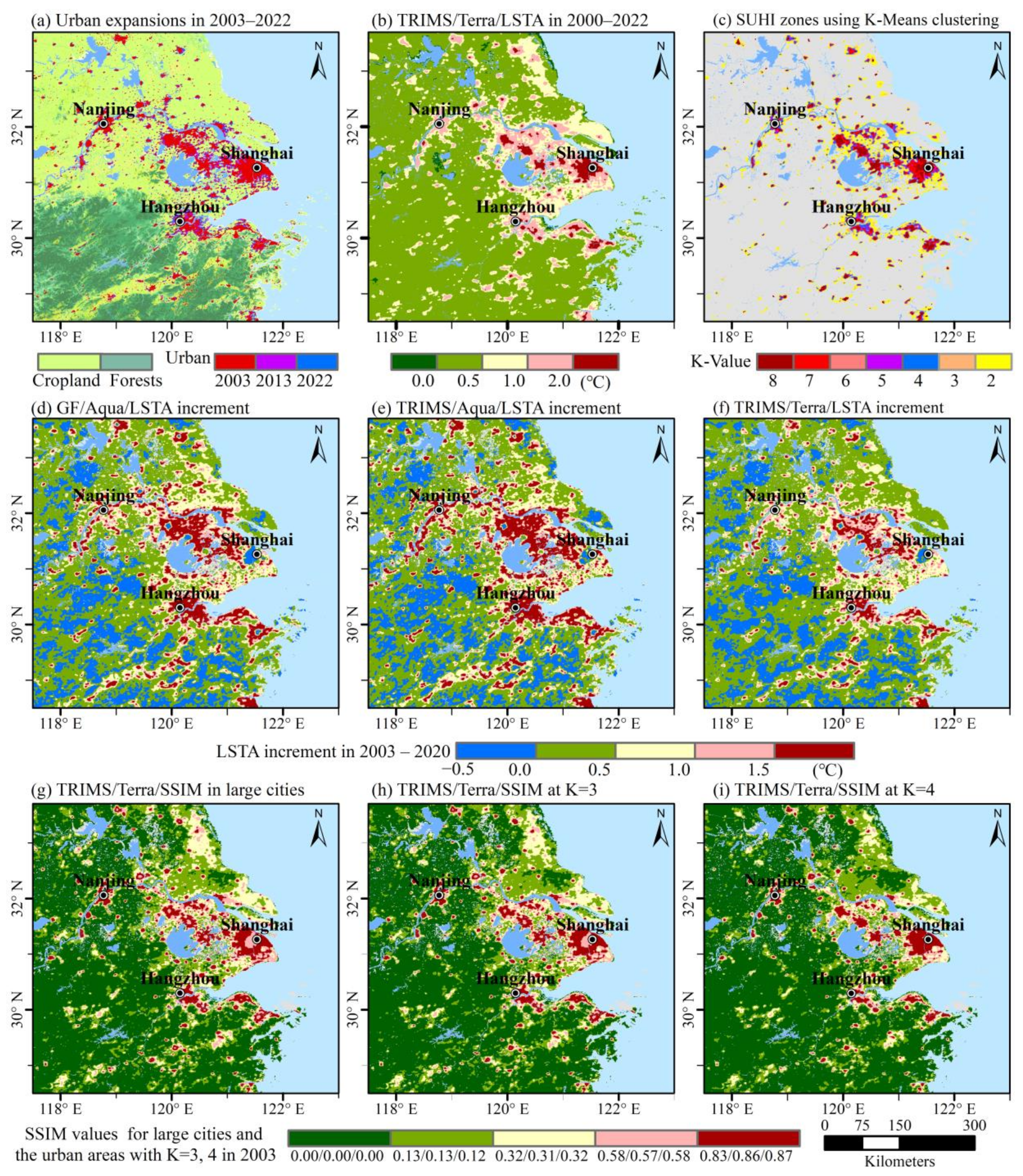
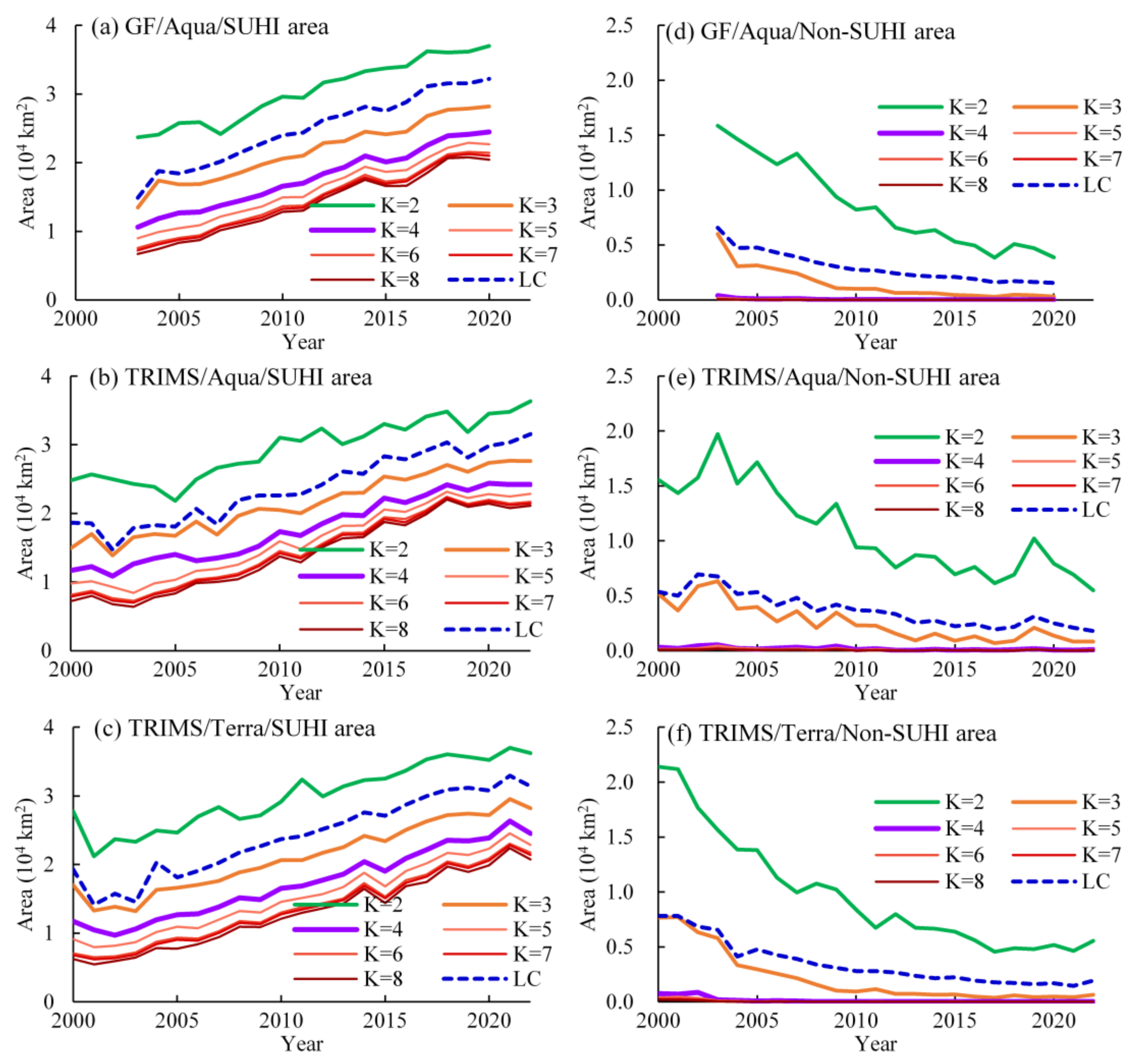

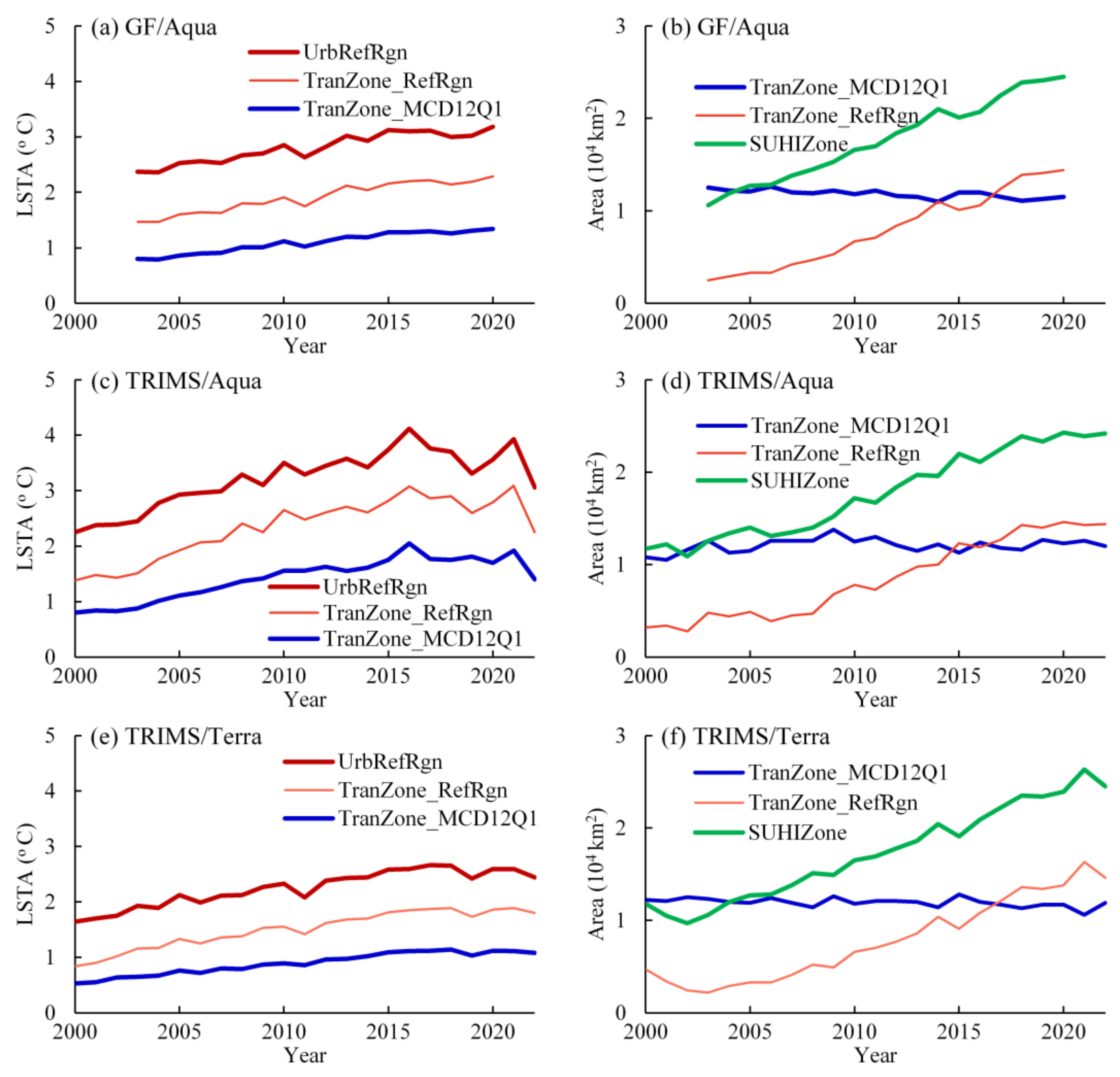
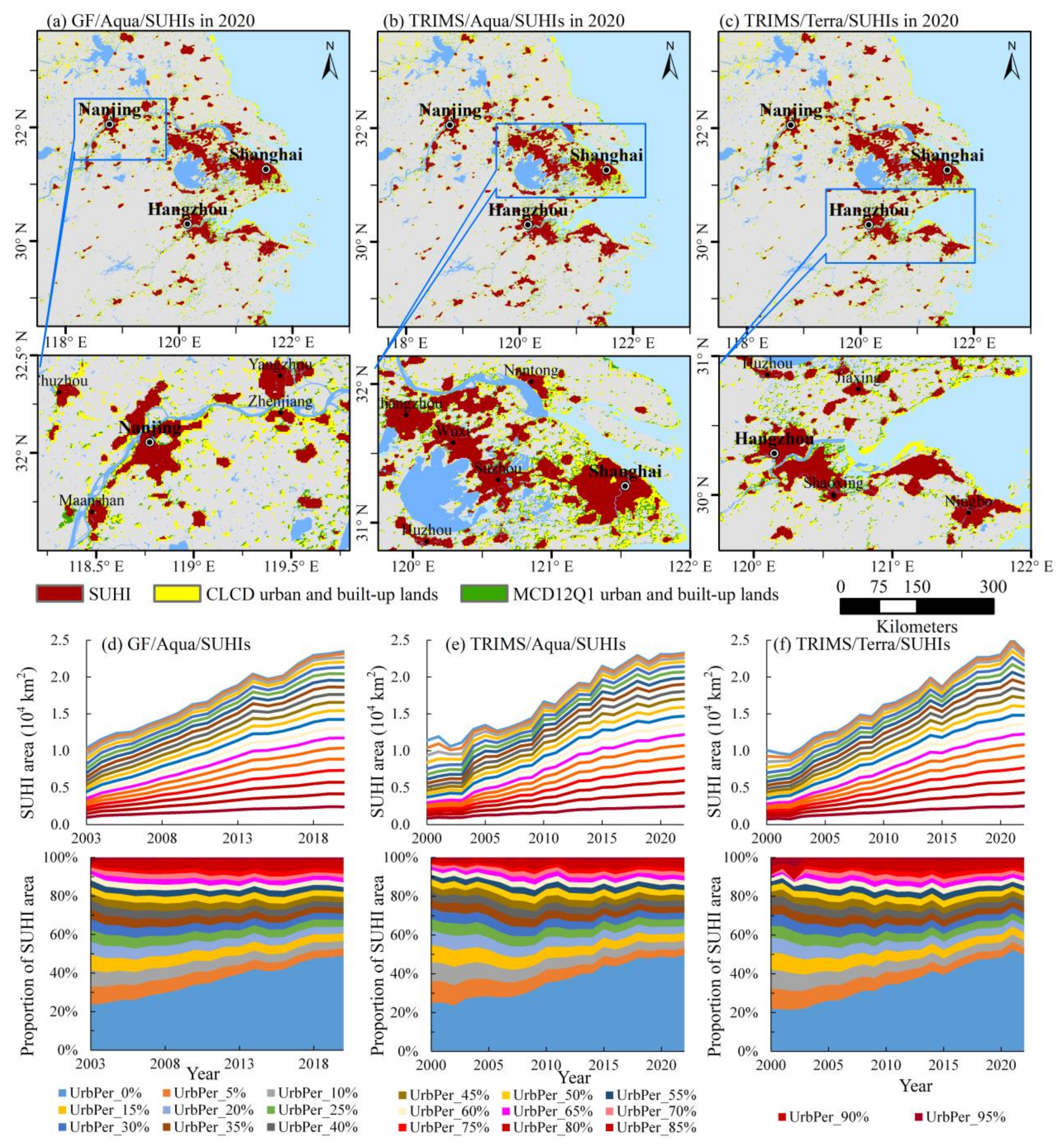

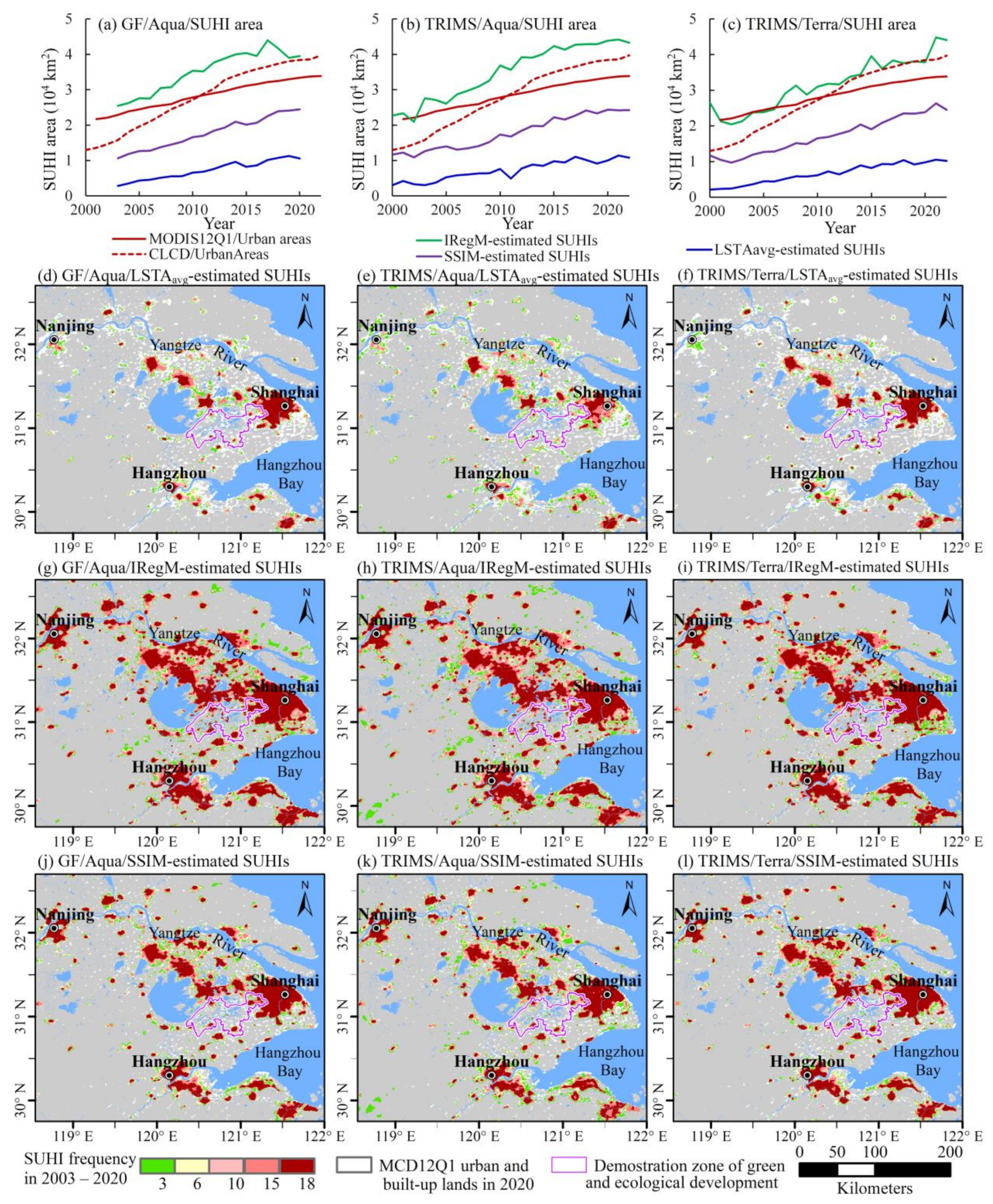
| SUHI levels | Weak | Moderate | Severe | |||||||
| 2 °C | 3 °C | 4 °C | 5 °C | 6 °C | 7 °C | 8 °C | 9 °C | 10 °C | ||
| Maximum SUHI | GF/Aqua | – | −0.17 | 0.38 | 0.39 | 0.23 | 0.07 | 0.02 | – | – |
| TRIMS/Aqua | – | −0.15 | 0.08 | 0.28 | 0.25 | 0.15 | 0.08 | – | – | |
| TRIMS/Terra | −0.18 | 0.29 | 0.4 | 0.21 | 0.05 | 0.01 | – | – | – | |
| SUHI levels | Weak | Moderate | Severe | |||||||
| 0.5 °C | 1.0 °C | 1.5 °C | 2.0 °C | 2.5 °C | 3.0 °C | 3.5 °C | 4.0 °C | 4.5 °C | ||
| Averaged SUHI | GF/Aqua | – | −0.14 | −0.01 | 0.41 | 0.32 | 0.18 | 0.06 | 0.01 | – |
| TRIMS/Aqua | – | −0.13 | −0.14 | 0.11 | 0.28 | 0.24 | 0.16 | 0.09 | 0.05 | |
| TRIMS/Terra | −0.12 | −0.16 | 0.43 | 0.34 | 0.17 | 0.06 | 0.01 | – | – | |
| CLCD/ISAlevels | Low density | Moderate density | High density | |||||||
| 10% | 20% | 30% | 40% | 50% | 60% | 70% | 80% | 90% | 100% | |
| Tendency | −0.58 | −0.18 | −0.02 | 0.04 | 0.09 | 0.10 | 0.13 | 0.15 | 0.15 | 0.15 |
Disclaimer/Publisher’s Note: The statements, opinions and data contained in all publications are solely those of the individual author(s) and contributor(s) and not of MDPI and/or the editor(s). MDPI and/or the editor(s) disclaim responsibility for any injury to people or property resulting from any ideas, methods, instructions or products referred to in the content. |
© 2025 by the authors. Licensee MDPI, Basel, Switzerland. This article is an open access article distributed under the terms and conditions of the Creative Commons Attribution (CC BY) license (https://creativecommons.org/licenses/by/4.0/).
Share and Cite
Du, Y.; Xie, J.; Xie, Z.; Wang, N.; Zhang, L. Spatiotemporal Footprints of Surface Urban Heat Islands in the Urban Agglomeration of Yangtze River Delta During 2000–2022. Remote Sens. 2025, 17, 892. https://doi.org/10.3390/rs17050892
Du Y, Xie J, Xie Z, Wang N, Zhang L. Spatiotemporal Footprints of Surface Urban Heat Islands in the Urban Agglomeration of Yangtze River Delta During 2000–2022. Remote Sensing. 2025; 17(5):892. https://doi.org/10.3390/rs17050892
Chicago/Turabian StyleDu, Yin, Jiachen Xie, Zhiqing Xie, Ning Wang, and Lingling Zhang. 2025. "Spatiotemporal Footprints of Surface Urban Heat Islands in the Urban Agglomeration of Yangtze River Delta During 2000–2022" Remote Sensing 17, no. 5: 892. https://doi.org/10.3390/rs17050892
APA StyleDu, Y., Xie, J., Xie, Z., Wang, N., & Zhang, L. (2025). Spatiotemporal Footprints of Surface Urban Heat Islands in the Urban Agglomeration of Yangtze River Delta During 2000–2022. Remote Sensing, 17(5), 892. https://doi.org/10.3390/rs17050892





